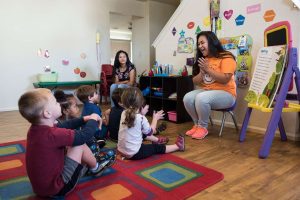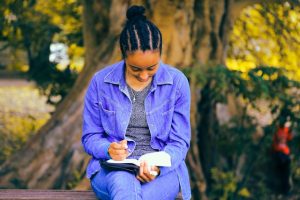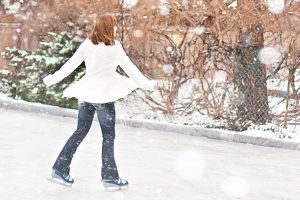16 Lesson 6C
1. Conectar. Connect the sentences describing what the students are doing with the corresponding picture.
Paso 1. Fill out the blanks with the vocabulary from the word bank.
| Word bank: crayones – universidad – béisbol. | |
| 1) Los estudiantes están jugando el ___________________ en el parque. |  |
| 2) El estudiante está estudiando en la biblioteca de su ___________________. |  |
| 3) El niño está dibujando con ___________________ en la sala de arte. |  |
Paso 2. Look at the pictures and tell a partner what level of school (universidad, colegio, escuela primaria, guardería) each student is attending.
- Los estudiantes de la foto A están estudiando en …
- …
- …
Paso 3. Look at the verbs used to describe the three pictures and work with a partner to answer the following questions.
- ¿Qué tipo de verbos estamos usando en las descripciones?
- ¿Cómo se forma este tiempo verbal?
Paso 4. Think about all the sports or activities at your own school or university. Write 2 sentences using the present progressive to describe the sports or activities that the students are doing this academic year.
- En la Universidad de Iowa, los estudiantes están…
2. Comparar. Look at the two pictures of classrooms from una guardería and un colegio. Work with a partner to take turns asking each other about the differences between the two pictures. Use your vocabulary from this module to talk about the pictures.
Modelo:
| Estudiante A | Estudiante B |
| ¿Qué diferencias hay entre las fotos? |
En la guardería, hay ______, y en el colegio, hay_____.
|
|
¿Qué semejanzas (similarities) hay entre las fotos?
|
En las dos fotos hay ___. |
A) La guardería
B) El colegio

3. Contestar. Work with a partner. Take turns asking each other who is doing the various activities and pastimes in the pictures of kindergarten, elementary, and college students below. Use the verbs in the bank to help you.
| Estudiar | Pintar | Patinar sobre hielo |
| Tocar el piano | Escribir un informe | Soplar burbujas |
| Volar una cometa | Compartir una manzana | Hacer yoga |
Modelo:
| Estudiante A | Estudiante B |
|
¿Quién está estudiando? / ¿Quiénes están estudiando?
|
Maya está estudiando. / Maya y Enrique están estudiando. |
|
Maya |

Luisa |

Pili |
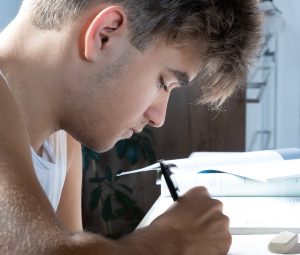
Enrique |

Pepe |

Pilar y Susana |
|
Ricardo |
Saylín |

Estela y Marta |
4. Completar. We have been using the verb estar a lot. Can you write down the conjugation for each verb?
| Yo … | Nosotros … |
| Tú estás | Vosotros estáis |
| Él, or elle… | Ellas … |
5. Leer. Read the short article about an international bilingual program. Fill in the blanks using the verb estar and then answer the following questions about it.
Un programa escolar de inmersión bilingüe.
¿Sabes que en Iowa existe un programa bilingüe internacional? El programa está ubicado (located) en el pueblo de West Liberty y es parte de la Academia Internacional de español que tiene apoyo del ministerio de educación en los Estados Unidos.
¿Qué están haciendo los estudiantes?
Los alumnos (A) ___________________ aprendiendo el contenido de clases en dos idiomas (español e inglés) al mismo tiempo. Este método los ayuda a tener mejor rendimiento académico y también los estudiantes están desarrollando las habilidades orales y de lectura. Es decir, los estudiantes son bilingües y bialfabetizados.
Al comenzar, los pequeños de kindergarten están aprendiendo matemáticas, ciencias sociales y lectura en español y tienen la clase de ciencias en inglés. Más adelante, los estudiantes del nivel quinto están ampliando el conocimiento de los cursos enseñados a través del español.
Todos los estudiantes (B) ___________________ escuchando sobre la cultura de los países hispanos y la de E.E. U.U. y así están avanzando en conocimiento para poder ser biculturales.
Este programa (C) ___________________ creciendo mucho y los estudiantes en niveles elementales y de secundaria pueden participar. ¡Puedes visitarlos!
Preguntas:
- ¿Dónde está ubicado el programa?
- ¿Qué materias (clases) están aprendiendo en español los estudiantes de kindergarten?
- ¿Qué materias están aprendiendo en inglés los estudiantes de kindergarten?
6. Escribir. Manuel is a Mexican student from the Universidad Autónoma de San Luis de Potosí who is doing a study abroad program at the Universidad de Chile. Read his email and then answer the following questions.
Hola Familia:
Me gusta el campus Andrés Bello de la Universidad. Estoy tomando clases de diseño, economía, estadística y también estoy cursando una clase de leyes laborales. Estoy leyendo un poco de Historia de Arquitectura Antigua y de la Tradición Moderna.
Los viernes por la noche, estoy yendo a fiestas con los amigos de la carrera de arquitectura. Algo chistoso: Los chilenos usan palabras diferentes y muy divertidas. Por ejemplo, al elote le llaman choclo. Y cuando tengo que hacer algo de inmediato, los chilenos dicen “Al tiro.” En fin, ya me estoy acostumbrando a sus dichos (expressions).
Nos vemos pronto, Manuel
Preguntas:
- ¿Qué clases está tomando Manuel?
- ¿Cuándo va a las fiestas?
- ¿Qué palabras divertidas usan los chilenos?
7. Investigar. Look at Activities 5 &6 of this lesson, and make a list of all the present progressive verbs you can find. Categorize them according to the table below.
| -AR Verbs | -IR Verbs | Irregular Verbs |
|
|
|
8. Leer. Read the following sentences.
Paso 1. Match the sentences to the corresponding picture.
| 1 – El pez está leyendo. |  |
| 2 – Pedro está durmiendo. |  |
| 3 – Mi compañera de cuarto está comiendo el proyecto. |  |
| 4 – Las tijeras están corriendo. | 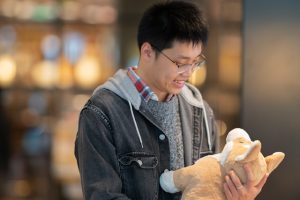 |
| 5 – Las plantas están construyendo una casa con Lego. |  |
| 6 – Estoy abrazando mi peluche. |  |
Paso 2. Determine if each sentence is plausible (posible) or ridiculous (ridículo).
9. Conjugar. Read the following sentences. Select and conjugate the irregular verb from the parentheses that best completes each sentence. Be sure to conjugate the verb in the present progressive form.
- Mis amigos y yo ___________________________ (traer / leer) nuestras novelas favoritas en el parque.
- Mi compañera de cuarto ___________________________ (servir / decir) comida en la cafetería.
- Tú ___________________________ (pedir / dormir) en la clase de historia porque el profesor está hablando mucho.
- En nuestra universidad, los trabajadores ___________________________ (venir / construir) muchos edificios nuevos.
- Trabajo en una guardería, y los niños y yo ___________________________ (servir / ir) a la biblioteca.
- Normalmente, como una ensalada grade para el almuerzo, pero esta vez yo ___________________________ (reír / pedir) una hamburguesa.
10. Discutir. Today we are going to create a podcast that talks about our hobbies. First we are going to listen to a podcast, then create some questions, and finally interview at least two classmates.
Paso 1. Listen to the model podcast and answer the following multiple choice questions.
1. ¿Qué libro está leyendo Yinet?
- Una historia de amor
- Una aventura en las montañas
- Un libro sobre ciencia
2. ¿Qué hace Yinet para relajarse después de leer?
- Está haciendo yoga
- Está tomando una siesta cada día
- Está leyendo un libro de ciencia ficción
- Está escuchando música
3. ¿Qué está haciendo Yinet para mantenerse en forma?
- Está yendo al gimnasio
- Está tomando una siesta
- Está haciendo yoga todas las mañanas
- Está jugando al fútbol
Paso 2. Listen to the model podcast one more time, and create a list of questions you would like to ask to your classmates.
- …
- …
Paso 3. It is time to start “recording” your podcast. Go around the class and interview at least two classmates.
11. Imaginar. Study the picture of this big family with children of all ages and imagine what some of the children are doing right now. Daniel attends daycare, Leo attends elementary school, Ana attends high school, and Nina is studying at a university.
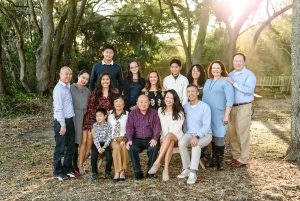
Paso 1. Using the regular and irregular verbs from the bank, write at least two sentences for each child. Be sure to conjugate them in the present progressive form (estar + -ando / -iendo).
| Dibujar | Leer | Estudiar | Comer | Escribir |
| Coser | Tocar | Hacer yoga | Practicar deportes | Jugar |
| Traer | Contar | Ir | Compartir | Invent your own |
Modelo:
Daniel está jugando en el arenero con sus amigos.
Paso 2. Share your sentences with a partner and see if any of the family members are doing the same thing.
12. Jugar. Form two teams and play a game of charades and/or pictionary using the presente progresivo expressions. Each team representative will draw a piece of paper and act out or draw the phrase.
Modelo:
| Estudiante A | Los otros estudiantes |
| Draws a slip of paper and acts out a person eating pizza. | Guess: Está comiendo pizza.. |

